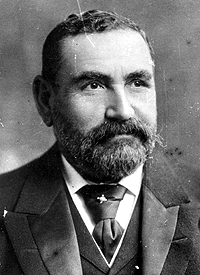See ministry
See ministry | |
|---|---|
30th Cabinet of theState of New South Wales | |
 | |
| Date formed | 28 March 1901 |
| Date dissolved | 14 June 1904 |
| People and organisations | |
| Monarch | Edward VII |
| Governor | The Earl Beauchamp/Sir Harry Rawson |
| Premier | Sir John See |
| No.of ministers | 12 |
| Member party | Progressive |
| Status in legislature | Minority government |
| Opposition party | Liberal Reform |
| Opposition leader | Charles Lee(1901–1902) Joseph Carruthers(1902–1904) |
| History | |
| Election | 1901 New South Wales election |
| Outgoing election | 1904 New South Wales election |
| Predecessor | Lyne ministry |
| Successor | Waddell ministry |
TheSee ministrywas the 30th ministry of theNew South Wales Government,and was led by the 14thPremier,Sir John See.[a]The title of Premier was widely used to refer to the Leader of Government, but was not a formal position in the government until 1920. Instead the Premier was appointed to another portfolio, usuallyColonial Secretary.
See was elected to theNew South Wales Legislative Assemblyin1880as member forGrafton,serving in the Dibbs and Lyne ministries, prior to assuming leadership of theProgressive Party.
Under the constitution, ministers in the Legislative Assembly were required to recontest their seats in an election when appointed.[2]Such ministerial by-elections were usually uncontested and on this occasion there were only three new ministers,Robert Fitzgerald,John KiddandThomas Waddelland all were re-elected unopposed.[3]Fitzgerald was defeated at the1901 election for Robertsonand was not replaced asMinister of JusticewithBernhard WiseKC,theAttorney General,taking on the additional responsibilities. Hugh Pollock, the secretary of the Attorney General's Department, was appointed as a non-politicalSolicitor Generalto assist the Attorney General by taking responsibility for committal proceedings.[4]Pollock's appointment was controversial because he was a public servant and had never practiced as a barrister.[5]Francis Suttorwas appointedPresident of the Legislative Councilin 1903 and was replaced in the ministry byKenneth Mackay.[6]
This was the first occasion in which ministers were appointed to theExecutive Council(or cabinet) without responsibility for a department or portfolio.[7]It was initially 2 ministersJames Hayes,[8]andWalter Bennett,[9]withJohn Feganadded in 1903.[10]They were not paid in addition to their allowance as a member of parliament,[b]did not have an "office of profit" and were not required to recontest their seats at a by-election.[7]
The ministry covers the period from 28 March 1901 until 14 June 1904,[6]when failing health and the death of his wife in March 1904 compelled him to retire.[13][1]See was succeeded by his Progressive Party colleague, Thomas Waddell.[6]

Composition of ministry[edit]
The composition of the ministry was announced by Premier See on 28 March 1901 and covers the period up to 14 June 1904.
| Portfolio | Minister | Party | Term start | Term end | Term length | |
|---|---|---|---|---|---|---|
| Premier Colonial Secretary Registrar of Records |
Sir John See [a] | Progressive | 28 March 1901 | 14 June 1904 | 3 years, 78 days | |
| Colonial Treasurer Collector of Internal Revenue |
Thomas Waddell | 10 April 1901 | 3 years, 65 days | |||
| Attorney-General | Bernhard WiseKC,MLC | 28 March 1901 | 3 years, 78 days | |||
| Minister of Justice | 22 July 1901 | 2 years, 328 days | ||||
| Robert Fitzgerald | 11 April 1901 | 16 July 1901 | 96 days | |||
| Secretary for Lands | Paddy Crick | 11 April 1901 | 14 June 1904 | 3 years, 64 days | ||
| Secretary for Public Works | Edward O'Sullivan | 28 March 1901 | 3 years, 78 days | |||
| Minister of Public Instruction Minister for Labour and Industry |
John Perry | 28 March 1901 | 3 years, 78 days | |||
| Secretary for Mines and Agriculture | John Kidd | 10 April 1901 | 3 years, 65 days | |||
| Vice-President of the Executive Council Representative of the Government in Legislative Council |
Francis SuttorMLC | 28 March 1901 | 23 May 1903 | 2 years, 56 days | ||
| Kenneth Mackay,MLC | 6 June 1903 | 14 June 1904 | 1 year, 8 days | |||
| Ministers without portfolio | James Hayes | 11 April 1901 | 3 years, 64 days | |||
| Walter Bennett | 16 April 1901 | 3 years, 59 days | ||||
| John Fegan | 24 March 1903 | 1 year, 82 days | ||||
Ministers were members of theLegislative Assemblyunless otherwise noted.
See also[edit]
- Federation of Australia
- Members of Legislative Assembly
- (1901-1904)
- Members of Legislative Council
- (1901–1904)
Notes[edit]
References[edit]
- ^abHenry, Keith."See, Sir John (1845–1907)".Australian Dictionary of Biography.Canberra: National Centre of Biography,Australian National University.ISBN978-0-522-84459-7.ISSN1833-7538.OCLC70677943.Retrieved10 July2021.
- ^Twomey, Anne(2004).The Constitution of New South Wales.Federation Press. pp.442.ISBN9781862875166.Retrieved24 November2020.
- ^Green, Antony."1898 to 1901 by-elections".New South Wales Election Results 1856-2007.Parliament of New South Wales.Retrieved10 July2021.
- ^"State politics: the vacant portfolio".The Sydney Morning Herald.9 July 1901. p. 5.Retrieved14 July2021– via Trove.
- ^Mason, K (2019)."Ch 1 Aspects of the History of the Solicitor-General in Australia".In Keyzer, P; Patrick (eds.).Public Sentinels: A Comparative Study of Australian Solicitors-General.Routledge.ISBN9781317073338.Retrieved19 January2019.
- ^abc"Part 6 Ministries since 1856"(PDF).NSW Parliamentary Record.Parliament of New South Wales.Retrieved4 March2020.
- ^ab"The state ministry".The Daily Telegraph.12 April 1901. p. 6.Retrieved10 July2021– via Trove.
- ^"Appointments to the Executive Council".Government Gazette of the State of New South Wales.No. 301. 11 April 1901. p. 2981.Retrieved10 July2021– via Trove.
- ^"Appointment to the Executive Council".Government Gazette of the State of New South Wales.No. 320. 16 April 1901. p. 3135.Retrieved10 July2021– via Trove.
- ^"Appointment to the Executive Council".Government Gazette of the State of New South Wales.No. 158. 24 March 1903. p. 2419.Retrieved11 July2021– via Trove.
- ^Parliamentary Representatives Allowance Act 1889(NSW).
- ^Clune, David & Griffith, Gareth (2006).Decision and Deliberation.pp.31-32.ISBN9781862875913.Retrieved11 July2021.
- ^Serle, Percival(1949)."See, Sir John (1844–1907)".Dictionary of Australian Biography.Sydney:Angus & Robertson.Retrieved22 August2011.
